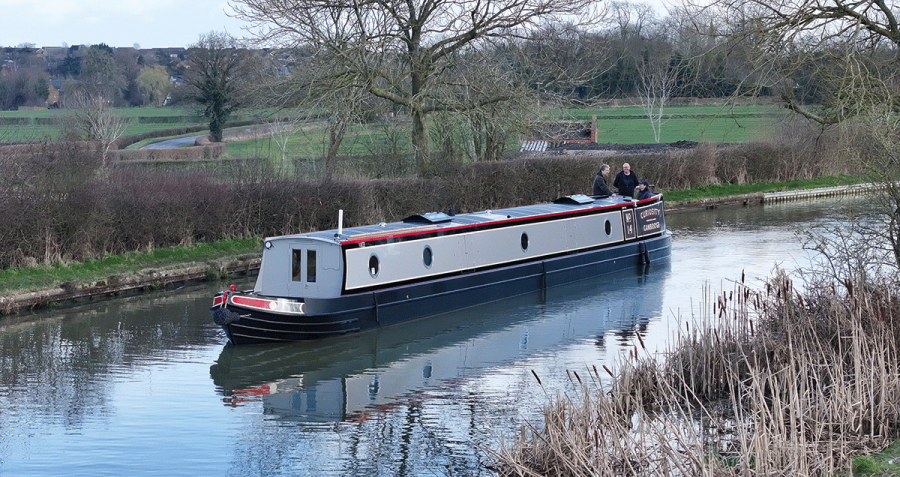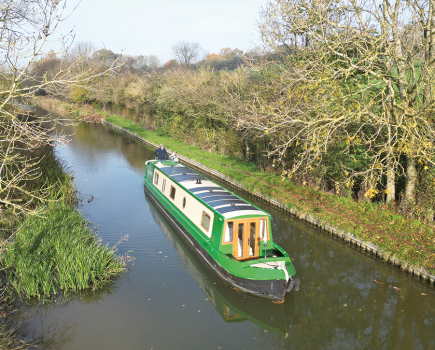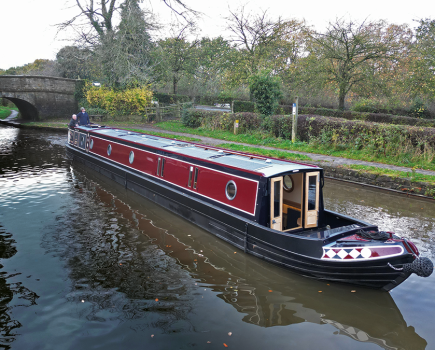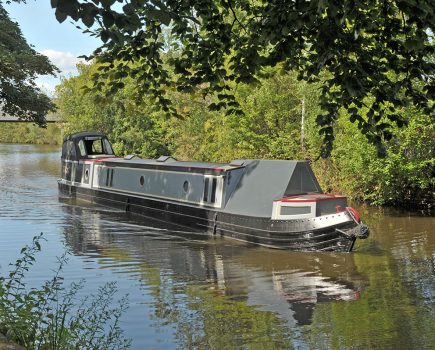This 68ft semi-trad boat features the latest in technology.
Words by Adam Porters | Pictures by Andy Annable
There are signs of spring all around us. The towpath hedgerows are tinged with green, and the daffodils are out. We’ve even had the occasional day when it didn’t rain – and by the time you read this, the clocks will have gone forward. And when spring is in the air, it means the Crick Boat Show can’t be far away.
Boating Leisure Services have a fantastic record at the show. They won the vote for Favourite Boat three times in a row between 2014 and 2016, and were triumphant again in 2019. But for one reason or another they haven’t exhibited at the show since the pandemic. But this year they’ll be back, and this is the boat they’ll be returning with.
And Curiosity is a bit special. It’s a properly bespoke 68ft boat whose design reflects exactly the way the owners want to use it. And it’s BLS’s first all-electric propulsion boat too. To say it’s loaded with clever ideas and the latest kit somewhat underestimates the situation.
EXTERIOR
This boat is built on a ColeCraft shell, so you know it’s going to be good quality. As you’d expect from such a well-established and respected name, all the steelwork looks good. It has the attractive ColeCraft bow, a nice long nose and well deck, and sits in the water very nicely. It looks substantial and has real presence, but there are also fine details, such as a finger grip along the handrails.
The semi-trad stern has lockers both sides, providing somewhere for crew to sit, as well as storage. One locker each side is designed to be the right size to hold a folding bike, while on one side there’s also a taller locker for mooring stakes and windlasses. All have lockable lids for security, and are in a teak effect decking that’s also used on all the decks. The control column has a number of cubby holes, one of which is designed to safely hold the helmsman’s beer glass. There’s also deck lighting which can be remotely controlled from a phone, so you can turn the lights on as you walk back from the pub. An outside tap means you can wash the mud off your boots, or give the dog (that the owners don’t yet have) a bit of a hose down too.
There are also lockers on both sides of the well deck, again with lockable lids. As this is a gas-free boat, the space in the nose is available for storage. It has a large lid, which rises on a gas strut – and in a genius move, the hosepipe reel is mounted underneath. It means the hosepipe is both out of the way, and always ready for use. The nose locker also has doors in the well deck bulkhead, to make access to the bow thruster easier. Another innovation is that the horn has an additional button at the bow, so someone sitting there can sound it to warn other boats or the helm, about something they may have missed.
A tall wi-fi antenna is mounted on the forward corner of the cabin. It has a remote control motor which can fold it down, if an upcoming bridge looks a bit too low. It can also be mounted on a 12ft pole for a better signal when moored up; all the extra cable needed is stored in a little locker in the forward bulkhead of the cabin.
There are two glazed dog boxes on the roof, one over the galley and the other over the main cabin. All the trim is in chrome. The portholes are by ChannelGlaze, and have double glazed full hoppers and a thermal break which should cut down on condensation.
The colour scheme uses the tried and tested combination of grey and black, with red handrails. The paint itself is a tough two-pack, applied in BLS’s paint shed by Dave Bishop.
LAYOUT AND FITOUT
The owners have had a boat for the past seven years, and like to take their friends with them. So when it came to this, their new boat, they’ve gone long, in order to provide guest accommodation.
It’s a reverse layout boat, with the galley at the stern. Next comes the dinette followed by the saloon, which has what we’ll call the downstairs loo. The main cabin is in the middle of the boat, with a walk-through shower room beyond. The guest room, which is set up as a day cabin, is at the bow.
It’s a clever layout, because there are three sleeping areas – dinette, main cabin, and guest cabin – and each has access to a loo. The main shower room is Jack-and-Jill style between the two cabins; the extra loo serves the main cabin and the dinette.
The fitout uses a combination of painted cabin sides and European oak. Below the gunwales, shadow gap tongue and groove is used, which gives some nice texture. The flooring throughout is a Luxury Vinyl Tile. Throughout the boat, the fitout is of a very high standard.
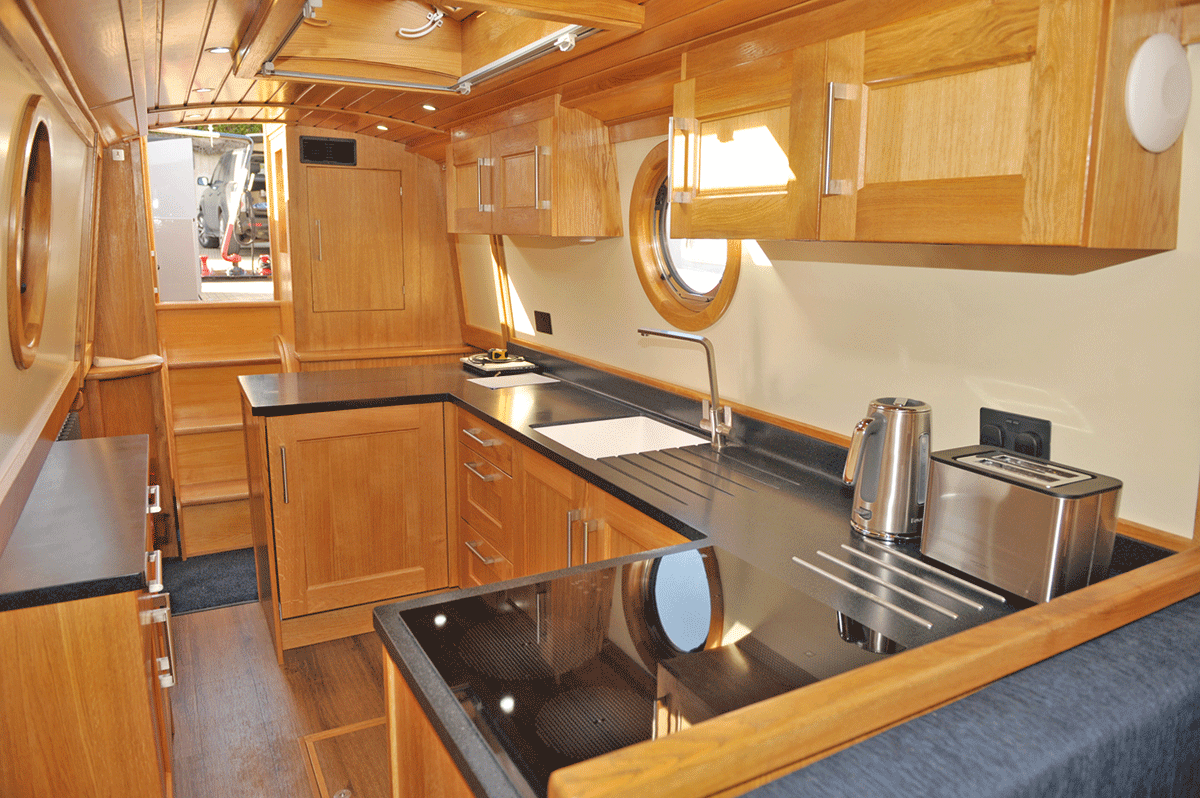
GALLEY
Steps lead down from the stern deck into the boat – and the whole step unit is removable to give access to the batteries, which are underneath. Alongside the steps there’s a drying cupboard with a heater in the bottom, ideal for wet coats. On the opposite side are all the technical displays and gauges; the door to the electrical cupboard is on the forward bulkhead. Before you get to the galley proper, there’s a kind of lobby space, with coat hooks and a boot tray, so you can get out of all your boating gear without taking mud through the boat.
The galley itself has a large U-shaped run of units on one side, all topped with Corian worktops in a dark grey. There’s a smaller unit of cupboards and drawers on the other side. There’s plentiful storage, enhanced by there being drawers in the plinths, and a wine store set into the floor. All the doors and drawers have soft closers. Equipment includes a Neff induction hob, and a Neff electric oven with a slide and hide door. The fridge is a full size 24-volt model by Shoreline.
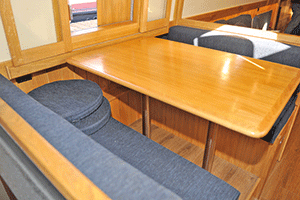
DINETTE
The owners reckon that most dinettes take up too much room on a boat, because they have to be 6ft 6in across to convert into a double bed. This one is only 5ft 6in when in dinette mode – and you really don’t notice that it’s smaller than average. But, cleverly, the forward bench can be unlocked and moved a foot, to create the full sized bed.
There’s storage in the bench seat which moves, while the other one has a Penguin pull-out freezer set into the end. There are side doors both sides, with sliding glazed inner doors, so you can have light without letting in all the weather.
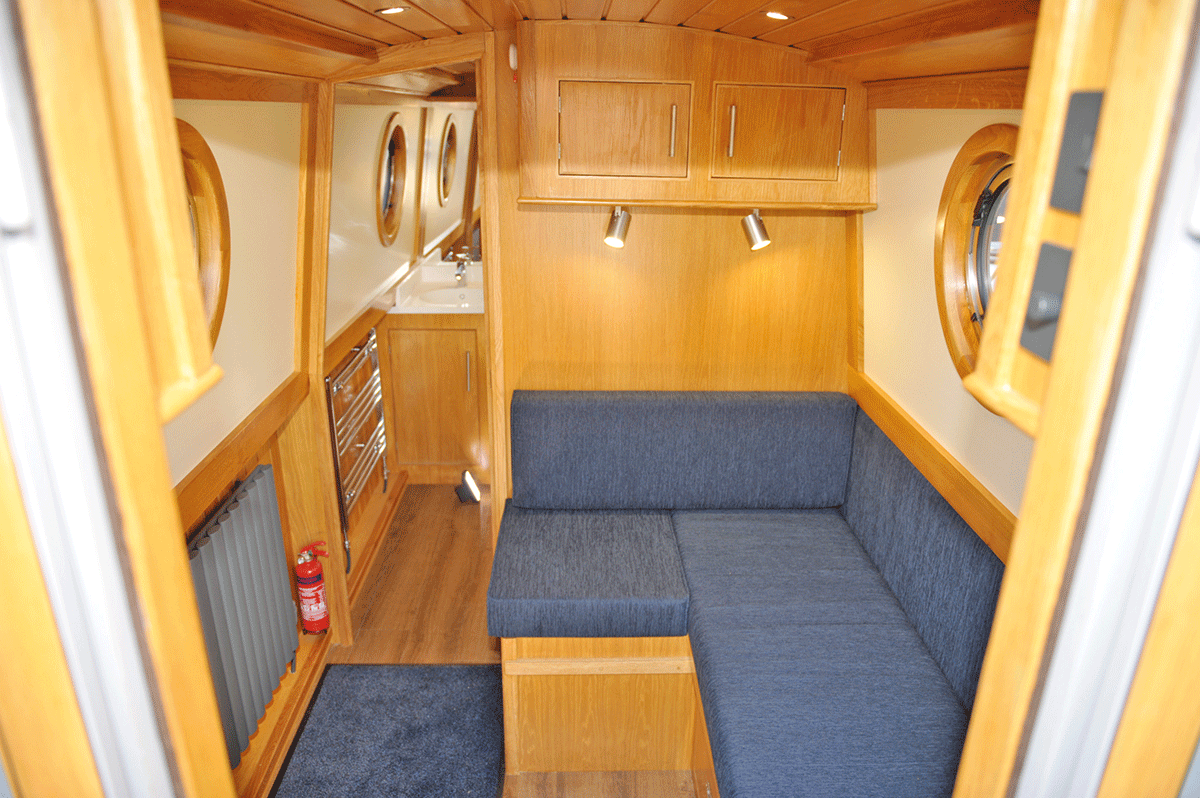
SALOON
The sofa is by Nabru – and because there’s ample guest accommodation it doesn’t need to be a sofa bed. It does, though, have storage in the base. The makers provided matching fabric for the dinette cushions.
Opposite is a low-level unit with a tv on top; it’s nice to see a tv in a boat that’s not huge; when you’re sitting just a few feet across from it, this screen is plenty big enough. The unit contains all the tech for streaming and so on.
Perhaps the lowest-tech piece of kit on the boat is the solid fuel stove. The owners have found they really like winter cruising, so a proper fire was a must. This one is a 4kw Woodpecker by ACR stoves; it’s DEFRA exempt, meaning it can burn wood in smoke control zones, and the manufacturers claim it’s one of the most efficient and clean burning on the market. It has a built in log store underneath, although this does make the flue a little shorter. The flue is double insulated, to meet current guidelines.
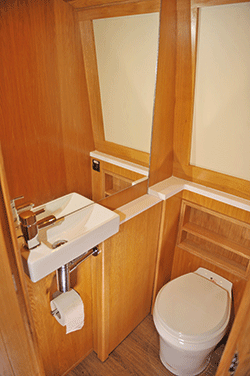 SECOND LOO
SECOND LOO
We’ve seen a few second loos on boats over the years, and this one is really quite a decent size. There’s not much to it, just a Headmaster macerator loo (which links to the same holding tank as the other toilet on board), and a small washbasin with a large mirror above.
But there is one remarkable thing about the room, designed to solve a problem which hasn’t actually occurred yet. The door between the saloon and the main cabin is a sliding pocket door. And to give access to the runners, the loo wall is hinged and can be pulled out. So if the door ever does come adrift, it should be easy enough to fix.
MAIN CABIN
The bed is across the boat, meaning it can be full width. To support the infill section, the base pulls out and rests on a support on the hull side opposite. The loo tank is in the bed base (on the centre line so it doesn’t affect trim) but the rest of the space is available for storage.
Either side of the bed is a tall wardrobe. Set into the sides are cubby holes complete with charging points, so you can charge a phone overnight, or keep a glass of water handy. If you need to get up in the night, floor level red lights lead the way to either the second loo or the main shower room, so you can see where you’re going without waking anyone else up. It’s a nice bright space, with a glazed dog box in the roof. This has a clever blind from the yachting world, which includes both a blind and a fly screen. There’s also a set of side doors, with glazed inners – but these inners have a one-way coating on them, so you can see out but people on the towpath can’t see in.
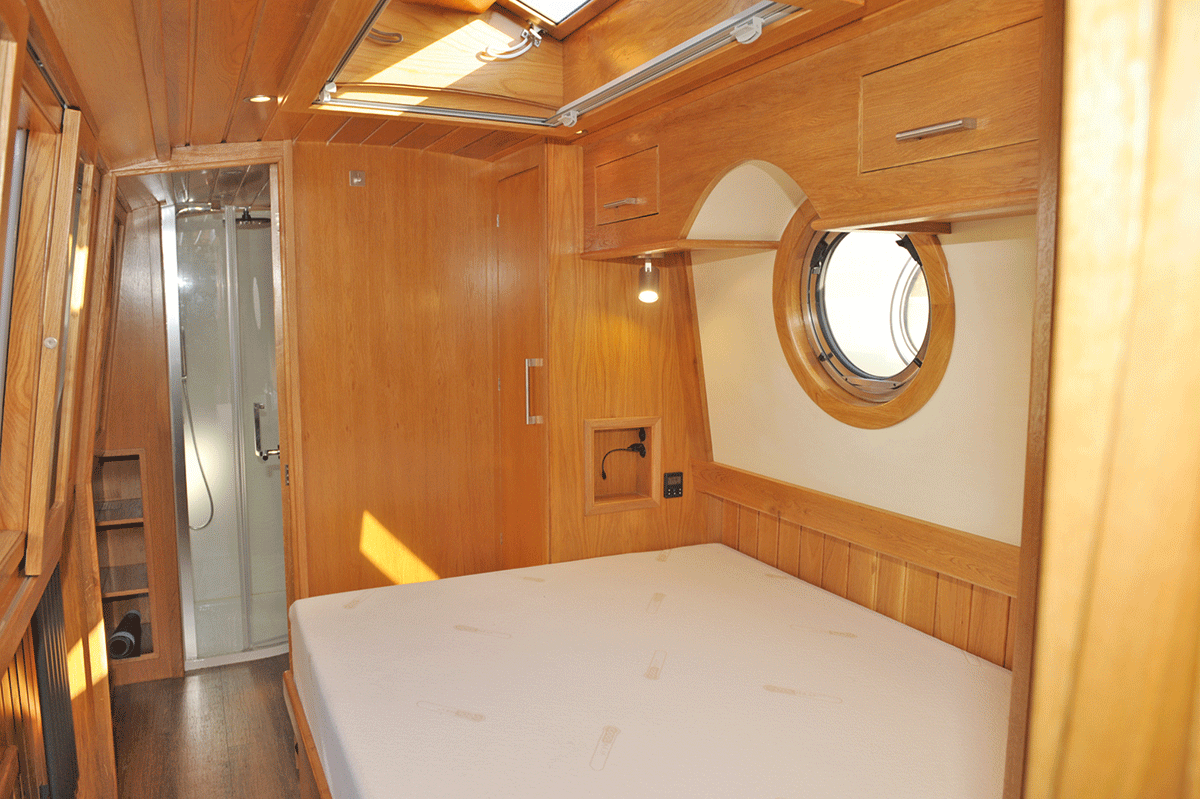
SHOWER ROOM
The quadrant shower is generously sized, at 800 x 900mm. The cubicle is lined with laminate, and the shower has both wall and ceiling mounted fittings. The toilet is by Headmaster, and has a little cubby hole built into the wall behind. The vanity unit has Corian worktops with an integrated sink. Above is a mirror and lighting. This room also has a heated towel rail.
DAYROOM
At the bow is the extra cabin, set up normally as a dayroom with built in L-shaped seating. It converts easily enough into a double bed for guests. For storage, there are high level cupboards, and a low unit to one side of the bow doors – although part of this is given over to a drinks fridge, so if you’re lounging on the well deck a top-up is close at hand.
TECHNICAL
Curiosity is an electric propulsion boat, and it’s powered by a 20kw Bell Marine water cooled electric motor. We’ve noticed recently that the size of motors being fitted to narrowboats seems to be creeping up. At first 10kw seemed to be the norm, then 15kw. The owners have spoken to lots of owners of electrically driven boats in the course of their research for this boat, and spotted that many had traded speed for economy; the amount of power used rises significantly the faster you go, so going slower conserves that precious resource. But the owners are both walkers, and often one will be striding the towpath while the other helms the boat – and they wanted to be able to travel at a decent walking pace.
This also explains the massive battery bank installed. There are eight 24-volt LiFePO4 lithium batteries from MG, together with a management system from the same maker. They’re wired in pairs, to give the 48-volt supply that the motor requires. The whole bank gives 1120Ah at 48 volts – which is a lot by any standards.
BLS boats typically use a 24-volt circuit for virtually all the electrical equipment on board, so there’s a Victron converter to take the 48 volts back down to 24. There’s another step down to 12 volts for the charging sockets. For a 240-volt supply, there’s a Victron 10kw 48-volt inverter charger.
The batteries can be charged in a variety of ways. There’s shore power if you’re in a marina. There’s also a 22Kw Fischer Panda DC generator, located in the engine bay. It’s the biggest model that would fit, because the owners were keen to minimise generator running times. They’ve calculated that an hour of generator time gives enough power for about five and a half hours of cruising. And that’s without taking into account the big solar array on the roof. There are 15 panels, each rated at 200 watts; they’re mounted on polycarbonate panels, which should stop them getting too hot in the summer, and makes allowances for the expansion and contraction of the boat’s shell. They are wired in three sections, with each five panels having their own Victron MPPT controller. The 3kw of solar should mean it’s not necessary to run the generator at all in the summer.
This is clearly quite a complicated system, so to make sense of what’s going on there’s a Victron GX Cerbo 70 monitoring system. There’s a colour display mounted at the stern so you can see at a glance the state of batteries and what’s being generated by the solar panels – and there’s an app so you can also get the information remotely on your phone. The level of complexity is perhaps illustrated by the fact that there’s 2,500 metres of cable used on board.
This boat has a Michigan four bladed propeller, which are claimed to be more efficient at low speed. The bow thruster is the brushless model by Vetus, which is joystick controlled and is proportional, so you can thrust either a little or a lot. Talking of things that are proportional, this boat has a water pump by Marco that works that way. Central heating is from an Eberspacher diesel boiler; this also has an app allowing remote control.
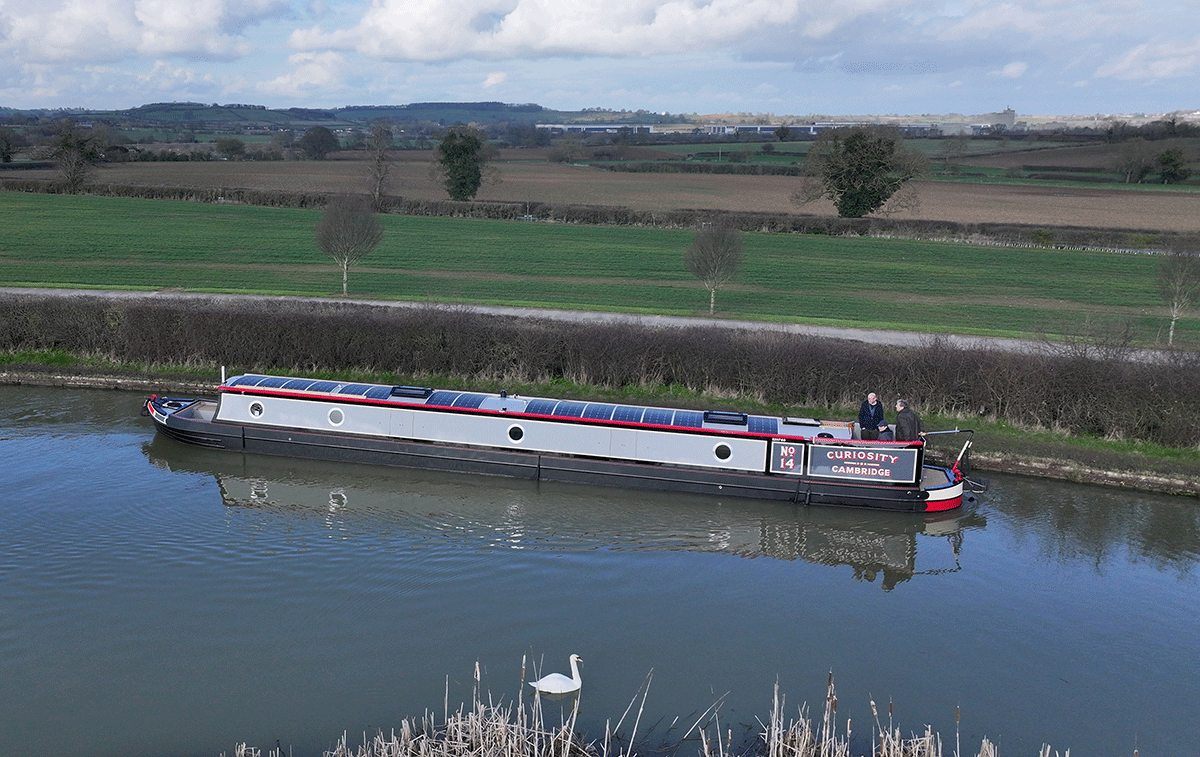
ON THE WATER
The quietness of an electric motor almost goes without saying these days. There’s a screen at the helm so you can see how much power the boat is using as you go along. The owners have found that when the display shows 3kw, the boat is going at about walking pace. The power of the big motor is clear when you come to stop – it does it very efficiently.
The boat handles really well, as you’d expect from a ColeCraft shell. We turned efficiently, once using the bow thruster and once without, and we also did a fair stretch in reverse, steering by bow thruster. Whatever we threw at the boat, it coped really well.
CONCLUSION
This is a boat that’s technologically very advanced. It’s loaded with kit – but of course this doesn’t come cheap. The total cost is around the £300,000 mark. That’s a lot – but the lithium batteries alone will have cost a significant sum, before you’ve considered all the other electrical equipment on board.
It’s also loaded with ideas, from the cleverly extending dinette to the hinged wall in the second loo, and has been built to meet very specific requirements from the owners. They know from their previous boat ownership how they use it, and this one has been designed to meet those needs.
This boat will be at the Crick Boat Show, so go and have a look for yourself.
The Owners
The owners of Curiosity have been boating for a long time. He first caught the bug on school trips, using traditional camping boats. He then introduced his wife to the canals when they got together. Holidays over many years were on the water, either canal boating or sailing in the Med. Then seven years ago, they bought a boat of their own – just to see how they got on with ownership, and to learn how they would use it. The lessons, such as the fact that they really enjoy having friends on board, explains many of the choices they made.
From all the technical equipment on board, you might guess that the owners both have a scientific bent. He worked as an electronic engineer, then ran a recruitment company to place engineers. She’s a scientist in the pharmaceutical industry. They’re both now semi-retired and able to spend a lot of time on board.
There’s an interesting story behind the name, Curiosity. It came from one of those calendars which had a motto for each day. One year, a long time ago, the motto on the owner’s birthday was ‘Curiosity makes life worth living’. He carried it around in his wallet for a couple of decades before it disintegrated, but the sentiment lives on in the name of the boat.
Specification
Length: 68ft
Beam: 6ft 10in
Shell: ColeCraft / www.colecraftboats.co.uk
Style: Semi-trad
Layout: Reverse
Berths: 2+2+2
Fit-out: European oak and painted panels
Electric motor: 20kw Bell Marine / www.bellmarine.tech
Generator: Fischer Panda 22kva / www.fischerpanda.com
Batteries: MG / www.mgenergysystems.eu
Bow thruster: Vetus brushless / www.vetus.com
Inverter: Victron 48 10kw / www.victronenergy.com
Stove: Woodpecker WP4LS / www.archeatproducts.com £699
Sofa: Nabru / www.nabru.co.uk from £448
Freezer: Penguin / www.penguinfrigo.co.uk From £843
CONTACT
Boating Leisure Services
Heyford Fields Marina, Bugbrooke Road
Nether Heyford, Northants, NN7 3NP
01604 833599
bls@boatingleisureservices.com
www.boatingleisureservices.com
£300,000
 As featured in the May 2024 issue of Canal Boat. Buy the issue here
As featured in the May 2024 issue of Canal Boat. Buy the issue here

